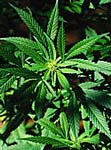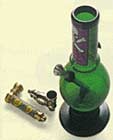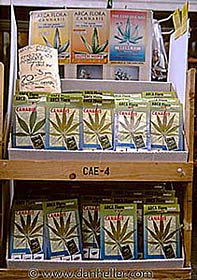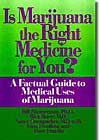What is Marijuana?
 Marijuana is the most widely used illicit drug in the United States (cocaine is second). Usage is not as high as it was in the late 1970s. However, the National Institute on Drug Abuse reports that nearly 60 million Americans over the age of 12 — about one in four — have tried marijuana at least once.
Marijuana is the most widely used illicit drug in the United States (cocaine is second). Usage is not as high as it was in the late 1970s. However, the National Institute on Drug Abuse reports that nearly 60 million Americans over the age of 12 — about one in four — have tried marijuana at least once.
Marijuana is a preparation of various parts (leaves, stems, flowers, seeds) of the hemp plant named Cannabis sativa. THC (tetrahydrocannabinol) is the main psychoactive ingredient in marijuana. Psychoactive means that it works on the nervous system.
 Commonly known as pot, weed, reefer, herb, or grass; there are more than 200 slang terms for marijuana. Although the main psychoactive ingredient in it is THC, the plant also contains more than 400 other chemicals. It is the amount of THC — (chemical name: delta-9-tetrahydrocannabinol — for all you chemistry lovers), that determines the potency of marijuana. Today’s pot is often up to eight times stronger than the marijuana of the seventies, according to the Drug Enforcement Administration. It can be mixed with other and more unpredictable drugs such as PCP. (If you do smoke it, buy it from someone you trust). I’ll take some heat from that comment for sure.
Commonly known as pot, weed, reefer, herb, or grass; there are more than 200 slang terms for marijuana. Although the main psychoactive ingredient in it is THC, the plant also contains more than 400 other chemicals. It is the amount of THC — (chemical name: delta-9-tetrahydrocannabinol — for all you chemistry lovers), that determines the potency of marijuana. Today’s pot is often up to eight times stronger than the marijuana of the seventies, according to the Drug Enforcement Administration. It can be mixed with other and more unpredictable drugs such as PCP. (If you do smoke it, buy it from someone you trust). I’ll take some heat from that comment for sure.
 Most often loose marijuana dried buds and leaves are rolled into a cigarette called a joint. It may also be smoked in a pipe or a water pipe called a bong. Over the past several years, it has appeared in cigars called “ blunts”. This makes it a popular form in some U.S. cities with college students as it appears that they are smoking a cigar and not marijuana. Blunts photograph, to the left. Blunts are made by slicing open cigars and replacing the tobacco with marijuana. Marijuana also is used to brew tea — although many say it is less poten that way and is sometimes mixed into foods, like the notorious pot or hash brownies.
Most often loose marijuana dried buds and leaves are rolled into a cigarette called a joint. It may also be smoked in a pipe or a water pipe called a bong. Over the past several years, it has appeared in cigars called “ blunts”. This makes it a popular form in some U.S. cities with college students as it appears that they are smoking a cigar and not marijuana. Blunts photograph, to the left. Blunts are made by slicing open cigars and replacing the tobacco with marijuana. Marijuana also is used to brew tea — although many say it is less poten that way and is sometimes mixed into foods, like the notorious pot or hash brownies.
It is also smoked in the form of hashish or hash. Hash is made by extracting the resin from the leaves and flowers of the marijuana plant and pressing it into cakes. It is stronger than marijuana and may contain five to ten times as much THC. Marijuana does not have the immediate, dramatic effects on health that deter many teens from trying drugs like crack and heroin. It does have long-lasting effects on the brain that can dramatically alter quality of life for daily smokers.
Some Effects of Marijuana

SHORT-TERM EFFECTS:
- Dry mouth and throat
- Increased heart rate
- Bloodshot eyes
- Impaired learning, memory, judgment and complex motor skills
- Difficulty speaking, listening, thinking, and problem solving
- Anxiety or panic attacks
- Paranoia in some users
- Distorted perception: (sight, sound, time, touch)
LONG-TERM EFFECTS:
- Psychological dependence
- Asthma
- Cancer of the lungs – as with anything smoked
- Lowered sperm production & decreased sperm mobility
- Immune system damage
- There is some evidence of long-term memory damage from “prolonged use”.
Differences Between Pot and Hash
 Both marijuana and hashish come from the Cannabis Sativa variety of the hemp plant. Users of both drugs get high from the resin content of the hemp’s flowering tops, especially from the female plants. Different strains of hemp produce varied quantities and qualities of resin. Most of the pot we see in the U.S. results when the entire plant-resin, leaves, and stalks are chopped up and combined, diluting the potency of the resin (which also keeps the cost down). Marijuana users prefer the “colas” or buds of the plant because of its higher THC content. Leaves and stems are often used as filler or thrown away in higher priced marijuana.
Both marijuana and hashish come from the Cannabis Sativa variety of the hemp plant. Users of both drugs get high from the resin content of the hemp’s flowering tops, especially from the female plants. Different strains of hemp produce varied quantities and qualities of resin. Most of the pot we see in the U.S. results when the entire plant-resin, leaves, and stalks are chopped up and combined, diluting the potency of the resin (which also keeps the cost down). Marijuana users prefer the “colas” or buds of the plant because of its higher THC content. Leaves and stems are often used as filler or thrown away in higher priced marijuana.
 H ash is created when just the sticky resin is collected and pressed into cake-like lumps, making it more potent than pot and more expensive. When the resin is extracted with solvents, it can be concentrated into thick hash oil. Both pot and hash can either be smoked or eaten. Sensemilla (sin-seh-me-yah) or pot without seeds can be as potent as hash. As domestic pot production increases and becomes more cultivated, so does the pot’s THC content. Short-term problems associated with the use of hash and sensemilla include extreme paranoia, anxiety, and panic attacks. These usually occur after inexperienced users smoke or eat strong substances is bad or hostile environments. (Photo of bong on the right).
H ash is created when just the sticky resin is collected and pressed into cake-like lumps, making it more potent than pot and more expensive. When the resin is extracted with solvents, it can be concentrated into thick hash oil. Both pot and hash can either be smoked or eaten. Sensemilla (sin-seh-me-yah) or pot without seeds can be as potent as hash. As domestic pot production increases and becomes more cultivated, so does the pot’s THC content. Short-term problems associated with the use of hash and sensemilla include extreme paranoia, anxiety, and panic attacks. These usually occur after inexperienced users smoke or eat strong substances is bad or hostile environments. (Photo of bong on the right).
Amotivational Syndrome
If you know someone who smokes a lot of pot, you are probably familiar with this syndrome, also known as a “burnout”. Amotivational Syndrome is characterized by decreased motivation – duh – decreased drive — including sex drive and ambition, shortened attention span, poor memory and judgment, impaired ability to concentrate, impaired communication skills and a diminished ability to have interpersonal relationships.
If someone you care about is experiencing Amotivational Syndrome or you want help yourself, get in touch with Marijuana Anonymous in the U.S. at 1-800-766-6779. ![]() For other resources on the web, see list at the bottom of the page.
For other resources on the web, see list at the bottom of the page.
MARIJUANA AND CANCER
Does marijuana smoke cause cancer?
 Conclusions about long-term drug effects need long-term research studies, and that’s why the jury is still out on some of the cannabis consequences that may show up later in life. (Or the “jury” is too stoned to say!) In spite of the fact that humans have been growing marijuana for thousands of years, and using it recreationally since the early twentieth century in the U.S., its effects have not been thoroughly studied as those of cigarette and tobacco smoking. What is known is that frequent marijuana users smoke less than heavy cigarette users. (It would be hard to smoke 20 joints a day). One thing to keep in mind, is that marijuana smokers tend to inhale more deeply and keep the smoke in their lungs for a longer period of time than tobacco smokers do. And if you smoke both — obviously, more chemicals are being inhaled. Burning marijuana when smoking releases many other substances than THC. THC does not appear to be carcinogenic (cancer-causing), but some of the other chemicals released by smoking are poisonous. These include tar, carbon monoxide, and cyanide. One known carcinogen, benzopyrene, found in both types of smoke, seems to be greater in marijuana smoke. Another problem with marijuana is that it is almost always smoked without a filter. Using one would cut down on the amount of these chemicals. Consuming pot through a water pipe — or bong — would eliminate some of the byproducts of smoking. Currently, it does appear that pot smokers may run an increased risk of cancer, as well as other health problems listed above. Some research has found a connection between pregnant marijuana smokers and rare childhood leukemias in their young children. However, there has not been enough research for this connection to be clear. For more information on marijuana use and cancer, call the American Cancer Society in the U.S. at
Conclusions about long-term drug effects need long-term research studies, and that’s why the jury is still out on some of the cannabis consequences that may show up later in life. (Or the “jury” is too stoned to say!) In spite of the fact that humans have been growing marijuana for thousands of years, and using it recreationally since the early twentieth century in the U.S., its effects have not been thoroughly studied as those of cigarette and tobacco smoking. What is known is that frequent marijuana users smoke less than heavy cigarette users. (It would be hard to smoke 20 joints a day). One thing to keep in mind, is that marijuana smokers tend to inhale more deeply and keep the smoke in their lungs for a longer period of time than tobacco smokers do. And if you smoke both — obviously, more chemicals are being inhaled. Burning marijuana when smoking releases many other substances than THC. THC does not appear to be carcinogenic (cancer-causing), but some of the other chemicals released by smoking are poisonous. These include tar, carbon monoxide, and cyanide. One known carcinogen, benzopyrene, found in both types of smoke, seems to be greater in marijuana smoke. Another problem with marijuana is that it is almost always smoked without a filter. Using one would cut down on the amount of these chemicals. Consuming pot through a water pipe — or bong — would eliminate some of the byproducts of smoking. Currently, it does appear that pot smokers may run an increased risk of cancer, as well as other health problems listed above. Some research has found a connection between pregnant marijuana smokers and rare childhood leukemias in their young children. However, there has not been enough research for this connection to be clear. For more information on marijuana use and cancer, call the American Cancer Society in the U.S. at ![]() 1-800-227-2345 or the National Cancer Institute at
1-800-227-2345 or the National Cancer Institute at ![]() 1-800-4-CANCER
1-800-4-CANCER
How long does marijuana stay in the body?
 We have had a lot of emails about this question. What is that about?
We have had a lot of emails about this question. What is that about? ![]() Generally, traces or metabolites of THC can be detected by standard urine testing methods several days after a smoking session. However, for people that smoke a lot, traces of THC can be detected for weeks and even up to a month after they have stopped using. A hair sample test may detect traces of marijuana up to one month, some sources say even 6 weeks. (This recently happened to a reader), BTW.
Generally, traces or metabolites of THC can be detected by standard urine testing methods several days after a smoking session. However, for people that smoke a lot, traces of THC can be detected for weeks and even up to a month after they have stopped using. A hair sample test may detect traces of marijuana up to one month, some sources say even 6 weeks. (This recently happened to a reader), BTW.
Marijuana as Medicine
 There are many medicinal benefits of marijuana, which some medical doctors say alleviates the pain and nausea associated with AIDS, cancer, cancer treatment, and other diseases. Currently there is a much politicized battle over cannabis use. Should the medical benefits of marijuana be established by more medical research, it would be a drug no different from most narcotic prescription drug throughout the world. There are several states in the United States where voters have approved referendums expressing varying degrees of support for medicinal uses of marijuana. The United Nations board that oversees international drug control treaties for the United Nations has recommended that governments sponsor impartial research into the medicinal benefits of marijuana.
There are many medicinal benefits of marijuana, which some medical doctors say alleviates the pain and nausea associated with AIDS, cancer, cancer treatment, and other diseases. Currently there is a much politicized battle over cannabis use. Should the medical benefits of marijuana be established by more medical research, it would be a drug no different from most narcotic prescription drug throughout the world. There are several states in the United States where voters have approved referendums expressing varying degrees of support for medicinal uses of marijuana. The United Nations board that oversees international drug control treaties for the United Nations has recommended that governments sponsor impartial research into the medicinal benefits of marijuana.
What is Marinol ® ?
 Marinol ® (dronabinol) is laboratory synthesized THC. The THC in Marinol ® is about the same as the THC found in marijuana, but it is produced synthetically to provide a pharmaceutically pure drug in a measured dose with proven clinical studies. Dronabinol contains just one of the more than 60 cannabinoids in the marijuana plant, many of which may contribute to its beneficial effects. But unlike marijuana, which is illegal under U.S. federal law, dronabinol provides a standardized THC concentration and is free of impurities such as leaves, bacteria and mold spores.
Marinol ® (dronabinol) is laboratory synthesized THC. The THC in Marinol ® is about the same as the THC found in marijuana, but it is produced synthetically to provide a pharmaceutically pure drug in a measured dose with proven clinical studies. Dronabinol contains just one of the more than 60 cannabinoids in the marijuana plant, many of which may contribute to its beneficial effects. But unlike marijuana, which is illegal under U.S. federal law, dronabinol provides a standardized THC concentration and is free of impurities such as leaves, bacteria and mold spores.
This is not an endorsement for this product, just information in case someone in your family or someone you know is taking this drug for medicinal reasons. (Never take another person’s medication). Marinol® has been studied for a number of different medical conditions. It is currently approved by the FDA for TWO uses: for the treatment of loss of appetite associated with weight loss in patients with AIDS. The second is for nausea and vomiting in patients receiving cancer chemotherapy whom are not responsive to other methods of treating nausea. Yes, sometimes marijuana is given by physicians for glaucoma and then it is smoked. This is currently a controversial treatment and beyond the scope of this site, but see Cannabis Preparations for Pain and stress caused by multiple sclerosis, epilepsy and other chronic illnesses . But what can be learned from the marijuana controversy is that your right to vote when you turn eighteen in the United States is very important and can change the future… your future.
- See: Cannabis Preparations for Pain for more on using marijuana for pain management.
One Reader’s View on Legalization:
“In the Netherlands, where the sale of marijuana is allowed to responsible adults age 18 or older, the use of marijuana by minors is five times less than what it is in the United States, according to the British Medical Journal. Regulating the sale of marijuana would raise tens of millions of dollars each year. This money could be used to fund substance abuse treatment upon demand for alcoholics and other addicts (currently, 90% of these people are turned away when seeking treatment) as well as eliminate a large prison population. This is not the “cross over drug” that tobacco is and “The Cannabis Tax Act” would raise much-needed money”. – From Diana in Seattle, WA, USA
 Weighing Marijuana on a Scale. A coffee shop worker weighs marijuana on a scale. With the legalization of marijuana in the Netherlands many coffee shops in Amsterdam sell the drug. |
 Cannabis plants are cultivated at Positronics, a marijuana grow shop that supplies everything necessary for growing marijuana including plants, seeds, soil, lights, and water pumps. |
Photo of a seed shop in Holland

Photo: danheller.com
This following was sent in by Matt W. from the University of Chicago. It is not necessarily the view of Teen Health Secrets, but we thought it was worth printing, and certainly food for thought.
“T he stance that marijuana is a dangerous drug of abuse is a superficial propaganda for the masses. Marijuana was made illicit in 1937 to remove a threat to the new synthetic fibers made by the Dupont Company. The useful hemp fibers can grow to lengths of 6 meters, are very strong and were a threat to the success of Dupont.
If we are to consider health factors, then why do we legalize dangerous drugs such as alcohol and tobacco, both of which are very lethal. We can’t make people stop using things they want to use just by passing a law. (Look what happened during ‘Prohibition’).
The drug “trade” is now the single largest money operation in the U.S. economy and the money it generates is used to see that the laws will not change. I was recently told by a professor that the current value of the U.S. drug trade is estimated at around $600 billion dollars. The only real function making a drug illegal is to create a “black market”, otherwise known as ‘money-for-nothing’.
Marijuana isn’t even important to those in the ‘big money drug trade’, except for maintaining the ‘wall of prohibition’. It isn’t a question of what’s good for you or what’s bad for you. Alcohol gives us a perfect example of this hypocrisy. I’ve seen more college students in an alcohol induced stupor than any from marijuana — which appears to just mellow people out (and both are very available on campus).
The money paid for drugs is not based on the real value of the drugs themselves, but on the risk of transport, which in turn is the result of the law. This present us with an economic crisis of enormous impact, as a person with no skills or education can have a tax-free income greater than that of the highest paid individual in the entire industrial world. Such a situation destroys the basis of modern society, which is the assumption that a person is rewarded in direct relation to their contribution to the economic whole. The “war” on some drugs is not about drugs at all, but about money and the continued centralization of economic and political control.”
– Thank you for letting me express myself. – Matt W., University of Chicago, USA, Age 20 –
Marijuana Resources on the Web:
Medical and Recreational Marijuana Links – Lots of links and news.
Marijuana Addiction – Marijuana facts, research, news and links.
Marijuana Anonymous – The place to go for help with addiction.

National Organization for The Reform of Marijuana Laws – Great Information on legal issues and more.
Marijuana – Facts for Teens from the NIDA – A bit ‘slanted’, but informative.
More ‘ Drug Links‘… or to Substance Abuse
To share your views or your drug experiences, go to the ‘Experiences with Drugs’ page and share your opinions or stories with other readers from the link there. Thanks.
Related Reading, click for more information or to purchase.
 Is Marijuana the Right Medicine for You?Details marijuana’s uses for a wide range of illnesses, including cancer, AIDS, glaucoma, multiple sclerosis, epilepsy, migraines, and arthritis. Is Marijuana the Right Medicine for You?Details marijuana’s uses for a wide range of illnesses, including cancer, AIDS, glaucoma, multiple sclerosis, epilepsy, migraines, and arthritis. |
 Marijuana Myths, Marijuana Facts: A Review of the Scientific Evidenceby Lynn Zimmer; John P. Morgan; Ethan A. Nadelmann Marijuana Myths, Marijuana Facts: A Review of the Scientific Evidenceby Lynn Zimmer; John P. Morgan; Ethan A. Nadelmann |
 Go Ask Alice Go Ask Alice This groundbreaking classic is more compelling than ever for today’s readers. A sensation when it was first published and a perennial bestseller ever since, this real-life diary charts an anonymous teenage girl’s struggle with the seductive–and often fatal–world of drugs. |
 Marijuana RX: The Patient’s Fight for Medicinal Pot Marijuana RX: The Patient’s Fight for Medicinal Pot
|
